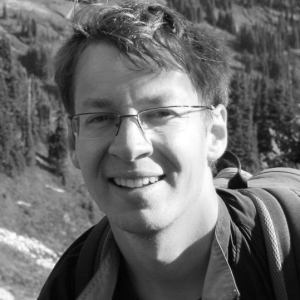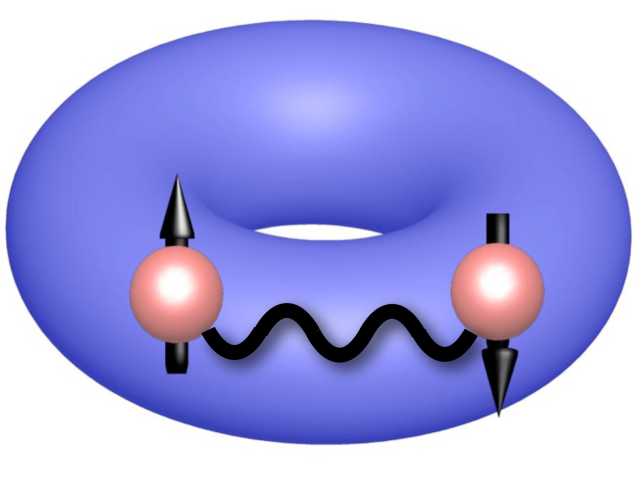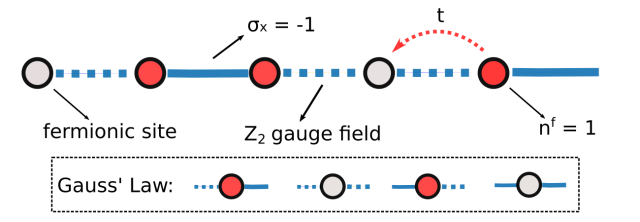
Fractionalized holes in one-dimensional Z2 gauge theory coupled to fermion matter: Deconfined dynamics and emergent integrability
A. Das, U. Borla, S. Moroz
Physical Review B 107 (6), 64302 (2023).
We investigate the interplay of quantum one-dimensional discrete Z2 gauge fields and fermion matter near full filling in terms of deconfined fractionalized hole excitations that constitute mobile domain walls between vacua that break spontaneously translation symmetry. In the limit of strong string tension, we uncover emergent integrable correlated hopping dynamics of holes which is complementary to the constrained XXZ description in terms of bosonic dimers. We analyze numerically quantum dynamics of spreading of an isolated hole together with the associated time evolution of entanglement and provide analytical understanding of its salient features. We also study the model enriched with a short-range interaction and clarify the nature of the resulting ground state at low filling of holes and identify deconfined hole excitations near the hole filling nu h = 1/3.

Confinement induced frustration in a one-dimensional Z2 lattice gauge theory
M. Kebric, U. Borla, U. Schollwöck, S. Moroz, L. Barbiero, F. Grusdt
New Journal of Physics 25 (1), 13035 (2023).
Coupling dynamical charges to gauge fields can result in highly non-local interactions with a linear confining potential. As a consequence, individual particles bind into mesons which, in one dimension, become the new constituents of emergent Luttinger liquids (LLs). Furthermore, at commensurate fillings, different Mott-insulating states can be stabilized by including nearest-neighbour (NN) interactions among charges. However, rich phase diagrams expected in such models have not been fully explored and still lack comprehensive theoretical explanation. Here, by combining numerical and analytical tools, we study a simple one-dimensional Z2 lattice gauge theory at half-filling, where U(1) matter is coupled to gauge fields and interacts through NN repulsion. We uncover a rich phase diagram where the local NN interaction stabilizes a Mott state of individual charges (or partons) on the one hand, and an LL of confined mesons on the other. Furthermore, at the interface between these two phases, we uncover a highly frustrated regime arising due to the competition between the local NN repulsion and the non-local confining interactions, realizing a pre-formed parton plasma. Our work is motivated by the recent progress in ultracold atom experiments, where such simple model could be readily implemented. For this reason we calculate the static structure factor which we propose as a simple probe to explore the phase diagram in an experimental setup.

Finding the ground state of a lattice gauge theory with fermionic tensor networks: A 2+1D Z2 demonstration
P. Emonts, A. Kelman, U. Borla, S. Moroz, S. Gazit, E. Zohar
Physical Review D 107 (1), 14505 (2023).
Tensor network states, and in particular projected entangled pair states (PEPS) have been a strong ansatz for the variational study of complicated quantum many-body systems, thanks to their built-in entanglement entropy area law. In this work, we use a special kind of PEPS-gauged Gaussian fermionic PEPS (GGFPEPS)-to find the ground state of 2 thorn 1 dimensional pure Z2 lattice gauge theories for a wide range of coupling constants. We do so by combining PEPS methods with Monte-Carlo computations, allowing for efficient contraction of the PEPS and computation of correlation functions. Previously, such numerical computations involved the calculation of the Pfaffian of a matrix scaling with the system size, forming a severe bottleneck,. in this work we show how to overcome this problem. This paves the way for applying the method we propose and benchmark here to other gauge groups, higher dimensions, and models with fermionic matter, in an efficient, sign-problem-free way.

Surface waves and bulk Ruderman mode of a bosonic superfluid vortex crystal in the lowest Landau level
B. Jeevanesan, C. Benzoni, S. Moroz
Physical Review B 106 (14), 144501 (2022).
We determine and analyze collective normal modes of a finite disk-shaped two-dimensional vortex crystal formed in a compressible bosonic superfluid in an artificial magnetic field. Using the microscopic Gross-Pitaevskii theory in the lowest Landau level approximation, we generate vortex crystal ground states and solve the Bogoliubov-de Gennes equations for small amplitude collective oscillations. We find chiral surface waves that propagate at frequencies larger than those of the bulk Tkachenko modes. Furthermore, we study low frequency bulk excitations and identify a Ruderman mode, which we find is well described by a previously developed low-energy effective field theory.

Rayleigh waves and cyclotron surface modes of gyroscopic metamaterials
F. Marijanovic, S. Moroz, B. Jeevanesan
Physical Review B 106 (2), 24308 (2022).
We investigate the elastic normal modes of two-dimensional media with broken time-reversal and parity symmetries due to a Lorentz term. Our starting point is an elasticity theory that captures the low-energy physics of a diverse range of systems such as gyroscopic metamaterials, skyrmion lattices in thin-film chiral magnets, and certain Wigner crystals. By focusing on a circular disk geometry, we analyze finite-size effects and study the low-frequency shape oscillations of the disk. We demonstrate the emergence of the Rayleigh surface waves from the bottom of the excitation spectrum and investigate how the curvature of the disk-boundary modifies their propagation at long wavelengths. Moreover, we discover a near-cyclotron-frequency wave that is almost completely localized at the boundary of the disk but is distinct from the Rayleigh wave. It can be distinguished from the latter by a characteristic excitation pattern in a small region near the center of the disk.

Fragmentation and Emergent Integrable Transport in the Weakly Tilted Ising Chain
A. Bastianello, U. Borla, S. Moroz
Physical Review Letters 128 (19), 196601 (2022).
We investigate emergent quantum dynamics of the tilted Ising chain in the regime of a weak transverse field. Within the leading order perturbation theory, the Hilbert space is fragmented into exponentially many decoupled sectors. We find that the sector made of isolated magnons is integrable with dynamics being governed by a constrained version of the XXZ spin Hamiltonian. As a consequence, when initiated in this sector, the Ising chain exhibits ballistic transport on unexpectedly long timescales. We quantitatively describe its rich phenomenology employing exact integrable techniques such as generalized hydrodynamics. Finally, we initiate studies of integrability-breaking magnon clusters whose leading-order transport is activated by scattering with surrounding isolated magnons.

Quantum phases of two-dimensional Z(2) gauge theory coupled to single-component fermion matter
U. Borla, B. Jeevanesan, F. Pollmann, S. Moroz
Physical Review B 105 (7), 75132 (2022).
We investigate the rich quantum phase diagram of Wegner's theory of discrete Ising gauge fields interacting with U (1) symmetric single-component fermion matter hopping on a two-dimensional square lattice. In particular limits, the model reduces to (i) pure Z(2) even and odd gauge theories, (ii) free fermions in a static background of deconfined Z(2) gauge fields, and (iii) the kinetic Rokhsar-Kivelson quantum dimer model at a generic dimer filling. We develop a local transformation that maps the lattice gauge theory onto a model of Z(2) gauge-invariant spin 1/2 degrees of freedom. Using the mapping, we perform numerical density matrix renormalization group calculations that corroborate our understanding of the limits identified above. Moreover, in the absence of the magnetic plaquette term, we reveal signatures of topologically ordered Dirac semimetal and staggered Mott insulator phases at half filling. At strong coupling, the lattice gauge theory displays fracton phenomenology with isolated fermions being completely frozen and dimers exhibiting restricted mobility. In that limit, we predict that in the ground state, dimers form compact clusters, whose hopping is suppressed exponentially in their size. We determine the band structure of the smallest clusters numerically using exact diagonalization. The rich phenomenology discussed in this paper can be probed in analog and digital quantum simulators of discrete gauge theories and in Kitaev spin-orbital liquids.

Rayleigh edge waves in two-dimensional crystals with Lorentz forces: From skyrmion crystals to gyroscopic media
C. Benzoni, B. Jeevanesan, S. Moroz
Physical Review B 104 (2), 24435 (2021).
We investigate, within the framework of linear elasticity theory, edge Rayleigh waves of a two-dimensional elastic solid with broken time-reversal and parity symmetries due to a Berry term. As our prime example, we study the elastic edge wave traveling along the boundary of a two-dimensional skyrmion lattice hosted inside a thin-film chiral magnet. We find that the direction of propagation of the Rayleigh modes is determined not only by the chirality of the thin film, but also by the Poisson ratio of the crystal. We discover three qualitatively different regions distinguished by the chirality of the low-frequency edge waves, and study their properties. To illustrate the Rayleigh edge waves in real time, we have carried out finite-difference simulations of the model. Apart from skyrmion crystals, our results are also applicable to edge waves of gyroelastic media and screened Wigner crystals in magnetic fields. Our work opens a pathway towards controlled manipulation of elastic signals along boundaries of crystals with broken time-reversal symmetry.

Gauging the Kitaev chain
U. Borla, R. Verresen, J. Shah, S. Moroz
Scipost Physics 10 (6), 148 (2021).
We gauge the fermion parity symmetry of the Kitaev chain. While the bulk of the model becomes an Ising chain of gauge-invariant spins in a tilted field, near the boundaries the global fermion parity symmetry survives gauging, leading to local gauge-invariant Majorana operators. In the absence of vortices, the Higgs phase exhibits fermionic symmetry-protected topological (SPT) order distinct from the Kitaev chain. Moreover, the deconfined phase can be stable even in the presence of vortices. We also undertake a comprehensive study of a gently gauged model which interpolates between the ordinary and gauged Kitaev chains. This showcases rich quantum criticality and illuminates the topological nature of the Higgs phase. Even in the absence of superconducting terms, gauging leads to an SPT phase which is intrinsically gapless due to an emergent anomaly.

Fracton-elasticity duality of two-dimensional superfluid vortex crystals: defect interactions and quantum melting
D. X. Nguyen, A. Gromov, S. Moroz
Scipost Physics 9 (5), 76 (2020).
Employing the fracton-elastic duality, we develop a low-energy effective theory of a zero-temperature vortex crystal in a two-dimensional bosonic superfluid which naturally incorporates crystalline topological defects. We extract static interactions between these defects and investigate several continuous quantum transitions triggered by the Higgs condensation of vortex vacancies/interstitials and dislocations. We propose that the quantum melting of the vortex crystal towards the hexatic or smectic phase may occur via a pair of continuous transitions separated by an intermediate vortex supersolid phase.

Thermodynamics of two-dimensional bosons in the lowest Landau level
B. Jeevanesan, S. Moroz
Physical Review Research 2 (3), 33323 (2020).
We study the thermodynamics of short-range-interacting, two-dimensional bosons constrained to the lowest Landau level. When the temperature is higher than other energy scales of the problem, the partition function reduces to a multidimensional complex integral that can be handled by classical Monte Carlo techniques. This approach takes the quantization of the lowest Landau level orbits fully into account. We observe that the partition function can be expressed in terms of a function of a single combination of thermodynamic variables, which allows us to derive exact thermodynamic relations. We determine the asymptotic behavior of this function and compute some thermodynamic observables numerically.

Hall viscosity and conductivity of two-dimensional chiral superconductors
F. Rose, O. Golan, S. Moroz
Scipost Physics 9 (1), 6 (2020).
We compute the Hall viscosity and conductivity of non-relativistic two-dimensional chi-ral superconductors, where fermions pair due to a short-range attractive potential, e.g. p + ip pairing, and interact via a long-range repulsive Coulomb force. For a logarithmic Coulomb potential, the Hall viscosity tensor contains a contribution that is singular at low momentum, which encodes corrections to pressure induced by an external shear strain. Due to this contribution, the Hall viscosity cannot be extracted from the Hall conductivity in spite of Galilean symmetry. For mixed-dimensional chiral superconductors, where the Coulomb potential decays as inverse distance, we find an intermediate behavior between intrinsic two-dimensional superconductors and superfluids. These results are obtained by means of both effective and microscopic field theory.

Confined Phases of One-Dimensional Spinless Fermions Coupled to Z(2) Gauge Theory
U. Borla, R. Verresen, F. Grusdt, S. Moroz
Physical Review Letters 124 (12), 120503 (2020).
We investigate a quantum many-body lattice system of one-dimensional spinless fermions interacting with a dynamical Z(2) gauge field. The gauge field mediates long-range attraction between fermions resulting in their confinement into bosonic dimers. At strong coupling we develop an exactly solvable effective theory of such dimers with emergent constraints. Even at generic coupling and fermion density, the model can be rewritten as a local spin chain. Using the density matrix renormalization group the system is shown to form a Luttinger liquid, indicating the emergence of fractionalized excitations despite the confinement of lattice fermions. In a finite chain we observe the doubling of the period of Friedel oscillations which paves the way towards experimental detection of confinement in this system. We discuss the possibility of a Mott phase at the commensurate filling 2/3.

Boundary central charge from bulk odd viscosity: Chiral superfluids
O. Golan, C. Hoyos, S. Moroz
Physical Review B 100 (10), 104512 (2019).
We derive a low-energy effective field theory for chiral superfluids, which accounts for both spontaneous symmetry breaking and fermionic ground-state topology. Using the theory, we show that the odd (or Hall) viscosity tensor, at small wave vector, contains a dependence on the chiral central charge c of the boundary degrees of freedom, as well as additional nonuniversal contributions. We identify related bulk observables which allow for a bulk measurement of c. In Galilean invariant superfluids, only the particle current and density responses to strain and electromagnetic fields are required. To complement our results, the effective theory is benchmarked against a perturbative computation within a canonical microscopic model.

Helical spin texture in a thin film of superfluid 3He
T. Brauner, S. Moroz
Physical Review B 99, 214506 (2019).
We consider a thin film of superfluid 3He under conditions that stabilize the A phase. We show that in the presence of a uniform superflow and an external magnetic field perpendicular to the film, the spin degrees of freedom develop a nonuniform, helical texture. Our prediction is robust and relies solely on Galilei invariance and other symmetries of 3He, which induce a coupling of the orbital and spin degrees of freedom. The length scale of the helical order can be tuned by varying the velocity of the superflow and the magnetic field and may be in reach of near-future experiments.

Bosonic Superfluid on the Lowest Landau Level
S. Moroz, D. T. Son
Physical Review Letters 122 (23), 235301 (2019).
We develop a low-energy effective field theory of a two-dimensional bosonic superfluid on the lowest Landau level at zero temperature and identify a Berry term that governs the dynamics of coarse-grained superfluid degrees of freedom. For an infinite vortex crystal we compute how the Berry term affects the low-energy spectrum of soft collective Tkachenko oscillations and nondissipative Hall responses of the particle number current and stress tensor. This term gives rise to a quadratic in momentum term in the Hall conductivity, but does not generate a nondissipative Hall viscosity.


